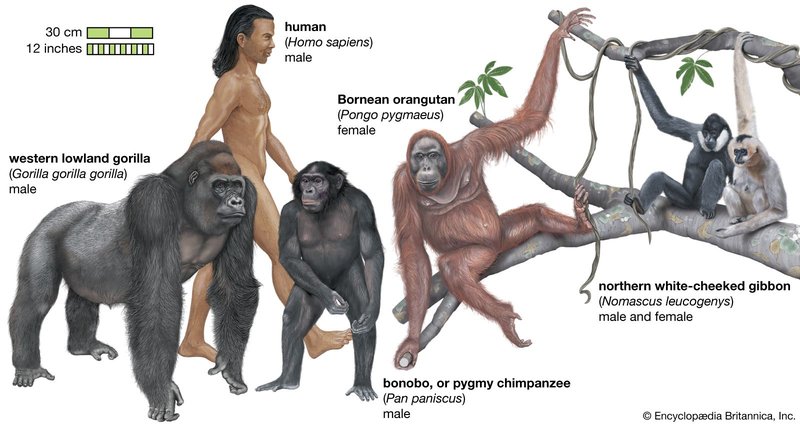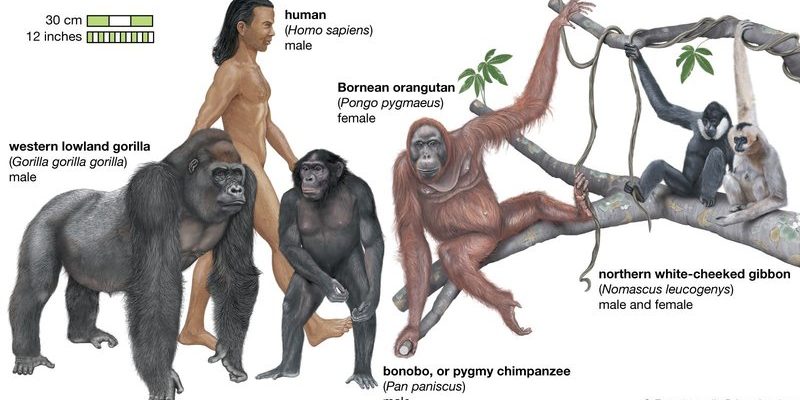
Imagine if you had two siblings who took very different paths in life. That’s kind of what happened with bonobos and chimpanzees. They share a common ancestor but adapted to their unique environments and social structures over time. In this blog post, we’ll go on a journey through the evolutionary history of bonobos, exploring their origins, behavior, and the fascinating role they play in our understanding of human evolution. So, grab your favorite drink, and let’s dive in!
Bonobos: An Introduction
Bonobos (Pan paniscus) are one of the two species that belong to the *Pan* genus, the other being the common chimpanzee. What sets them apart? For starters, bonobos are often seen as the more gentle and peaceful of the two. They inhabit the lush, dense forests of the Democratic Republic of the Congo, where they thrive in a matriarchal society. This means that female bonobos typically hold more authority and leadership roles compared to males.
Now, you might be wondering why bonobos exhibit such unique behaviors. Their environment and social structures have influenced their evolution in fascinating ways. Unlike chimpanzees, who often compete for resources and assert dominance, bonobos have developed a more cooperative and sexual-based social structure, using social interactions as a way to resolve conflicts. It’s like hosting a family reunion where everyone hugs it out instead of squabbling over the last piece of pie!
Understanding Bonobo Evolution
To truly appreciate bonobos, it’s essential to understand their evolutionary backdrop. Bonobos and chimpanzees diverged from their common ancestor approximately 1.5 to 2 million years ago. This split led to two distinct paths in evolution, primarily due to geographical barriers. The Congo River acted as a natural divider—while chimpanzees flourished in the western regions, bonobos adapted to the lush forests in the south.
This geographical separation played a significant role in shaping their behaviors, diets, and social structures. Bonobos evolved in a more abundant environment, leading to a diverse diet rich in fruits, plants, and occasionally small animals. Their environment fostered a sense of community rather than competition, which is often a hallmark of chimpanzee behavior. Imagine a college campus where students share resources and help each other succeed, rather than competing for the top spot—this illustrates the essence of bonobo society.
Physical Traits and Adaptations
When looking at bonobos, you might notice some distinct physical traits. Bonobos have a smaller build than chimpanzees, with longer legs and a more slender body. Their facial features are also different; bonobos tend to have a more rounded face with a prominent forehead and smaller, more expressive eyes. These physical adaptations not only contribute to their unique appearance but also to their social interactions, as they rely heavily on nonverbal communication.
In terms of locomotion, bonobos are also quite agile. They can walk on two legs for longer distances than chimpanzees, showing a degree of bipedalism that hints at our own evolutionary journey. Most notable is their ability to navigate their tree-dense habitat with ease, often using both climbing and walking to move through the forest. This adaptability to their environment plays a crucial role in their survival and social dynamics.
Social Structure and Behavior
One of the most intriguing aspects of bonobo life is their highly complex social structure. Bonobos are known for forming strong social bonds, primarily through sexual interactions, grooming, and play. Unlike chimps, who often display aggression to establish dominance, bonobos use sexual behavior as a way to diffuse tension and build alliances. It’s like having a family where hugs and laughter replace shouting matches.
Their matriarchal society means that females generally have greater influence within the group. Mothers play a vital role in shaping the behavior of their offspring, teaching skills and social norms. Male bonobos often rely on their mothers for support, and this nurturing environment leads to more cooperative interactions among group members. Think of it as a close-knit community where everyone watches out for each other, promoting peace rather than rivalry.
Bonobos and Human Evolution
Bonobos offer valuable insights into our own evolutionary story. They share about 98.7% of their DNA with humans, making them one of our closest living relatives. Studying bonobos helps us understand how social structures and behaviors have influenced our own development as a species. The peaceful, cooperative nature of bonobos hints at the potential for compassion and collaboration within human societies.
Here’s the thing: the way bonobos resolve conflicts through social bonding challenges the traditional view of survival of the fittest. Instead of brute strength or competitiveness, bonobos show us that cooperation and emotional connections can be equally vital for thriving. This understanding invites us to reflect on our social behaviors and the importance of empathy in our lives.
Threats to Bonobos and Conservation Efforts
Despite their fascinating history, bonobos face significant threats. Habitat loss due to deforestation, illegal hunting, and the illegal pet trade are all pressing issues that endanger their populations. As humans continue to expand into their habitats, bonobos are losing the forests that provide them shelter and food.
Conservation efforts are underway to protect these remarkable creatures. Organizations are working to safeguard their habitats, educate local communities, and promote sustainable practices that can benefit both people and bonobos. It’s like a team effort—everyone has a role to play in ensuring a future where bonobos can thrive, just as we must protect our own environments for future generations.
The evolutionary history of the bonobo is a captivating journey that offers rich lessons about cooperation, empathy, and our shared lineage. By understanding the unique adaptations and social structures of bonobos, we can gain valuable insights into our own humanity. As we explore this fascinating branch of the primate family tree, let’s remember the importance of protecting these gentle creatures and their habitats for a brighter future. Bonobos remind us that peace and connection can flourish even in the wildest of places. So, next time you think of our primate relatives, consider the bonobo—not just as a species, but as a vital reminder of the power of community and compassion in both the animal world and our own.

